
1. What is Python?
Python is a high-level, interpreted programming language known for its simplicity and readability. It emphasizes code readability and allows developers to express concepts in fewer lines of code compared to other languages.
2. What are the key features of Python?
- Easy-to-learn syntax
- Object-oriented programming support
- Extensive standard library
- Integration capabilities with other languages
- Third-party modules and packages
3. Is Python a Programming or Scripting language?
Python is suitable for scripting, but in general, it is considered a general-purpose programming language.
For those aspiring to enhance their skills in Python, delve into our Python Training program.
4. What is the difference between a list and a tuple in Python?
A list is mutable, which means its elements can be changed, added, or removed. It is represented using square brackets ([]).
A tuple is immutable, which means its elements cannot be changed once defined. It is represented using parentheses (()).
Example:
# List example
my_list = [1, 2, 3]
my_list.append(4)
print(my_list) # Output: [1, 2, 3, 4]
# Tuple example
my_tuple = (1, 2, 3)
# my_tuple.append(4) # Error: Tuples are immutable
print(my_tuple) # Output: (1, 2, 3)
5. Explain the concept of list comprehension in Python.
List comprehension provides a concise way to create lists based on existing lists or other iterable objects. It combines the creation of a new list with a for loop and an optional conditional statement.
Example:
# Creating a list of squares using list comprehension
numbers = [1, 2, 3, 4, 5]
squares = [x ** 2 for x in numbers]
print(squares) # Output: [1, 4, 9, 16, 25]
6. How do you handle exceptions in Python?
Exceptions are handled using try-except blocks. The code that might raise an exception is placed inside the try block, and any potential exceptions are caught and handled in the except block.
Example:

7. What is the difference between '==' and 'is' in Python?
In Python, the '==' operator compares the values of two objects, while the 'is' operator checks if two objects are the same object in memory. For example:
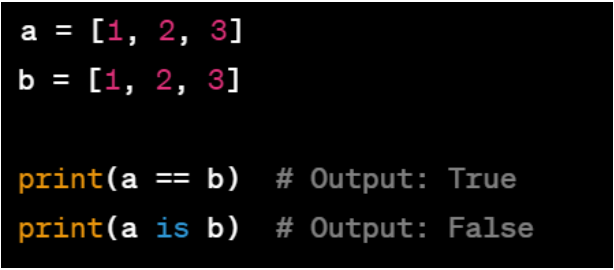
8. How do you generate random numbers in Python?
This again is an important Python interview question for beginners. In Python, random numbers are generated using the Random module. The method used is:
Import random
Random.random ()
9. What are generators in Python?
Generators in Python are functions used to return an iterable set of user-defined data types.
10. What are Global and local variables?
Global Variables:
- Global variables are defined outside of any function or block, making them accessible from anywhere within the program.
- They have a global scope, meaning they can be accessed by any function or block within the program.
- Global variables persist throughout the execution of the program.
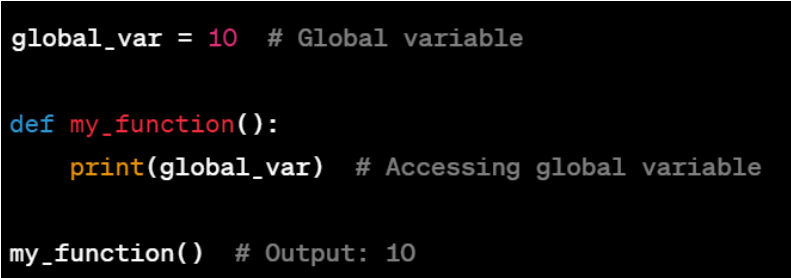
Local Variables:
- Local variables are defined within a function or block, and they are only accessible within that particular function or block.
- They have a local scope, meaning they cannot be accessed outside of the function or block in which they are defined.
- Local variables are created when the function or block is executed and are destroyed when the function or block exits.
Example:
def my_function():
local_var = 20 # Local variable
print(local_var)
my_function() # Output: 20
print(local_var) # Raises a NameError as local_var is not accessible outside the function.
Accessing a Global Variable within a Function:
- To access a global variable within a function, you need to use the global keyword before the variable name to indicate that you want to use the global variable instead of creating a new local variable with the same name.

It's important to note that modifying global variables within a function is generally discouraged, as it can make code harder to understand and lead to unexpected behavior. It is recommended to pass variables as function parameters or use return values to achieve the desired results.
11. What are the two major loop statements?
for and while
12. What is a Class in Python?
A Class in Python is a code template used to create and define an object. It is a fundamental block of code that defines the behavior and attributes of objects and functions.
13. Define an Object in Python
An Object in Python is a user-defined data type or instance of a class. It is an entity that exhibits behavior and state, defined by the Class that it is part of.
14. Mention the most widely-used built-in data types in Python?
The standard built-in data types in Python include:
- None Type
- Numeric Types
- Mapping Types
- Sequence Types
- Callable Types
- Modules
- Set Types
15. What is the difference between .py and .pyc files?
py files are Python source files. .pyc files are the compiled bytecode files that are generated by the Python compiler
16. Define string in Python.
In Python, a string is a sequence of characters enclosed within single quotes (' '), double quotes (" "), or triple quotes (""" """). Strings are immutable, which means they cannot be changed once created.
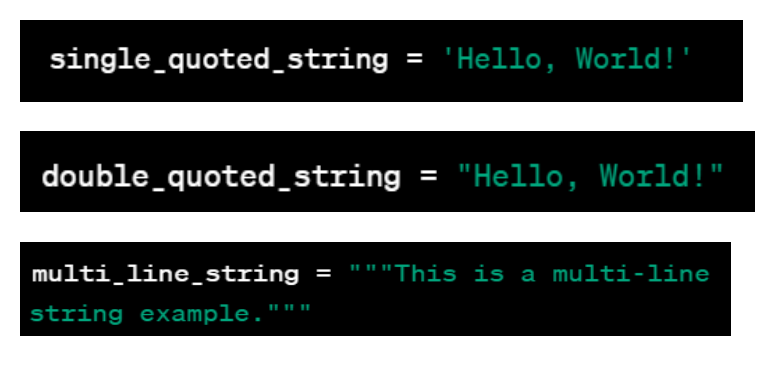
17. What is namespace in Python?
In Python, a namespace is a system that organizes and manages the names (identifiers) used in a program to avoid naming conflicts and provide a way to access and refer to objects. It is a mapping between names and objects.
Types of namespaces that are present in Python are:
- Local namespace
- Global namespace
- Built-in namespace
18. What is the purpose of the 'if name == "main"' statement?
It is used to check whether the current script is being run as the main module or being imported as a module by another script.
19. What is the purpose of the 'pass' statement in Python?
The 'pass' statement is a placeholder that does nothing. It is used when a statement is syntactically required but no action is needed.
What are lambda functions in Python?
Lambda functions, also known as anonymous functions, are small, one-line functions without a name.
What is the difference between append() and extend() methods in Python?
append() adds an element to the end of a list, while extend() adds multiple elements by appending them individually.
20. What is the Global Interpreter Lock (GIL) in Python?
The GIL is a mechanism in CPython (the reference implementation of Python) that allows only one thread to execute Python bytecode at a time.
21. What do you understand about type conversion in Python? What are some common functions to perform type conversions in Python?
Type conversion in Python is used to convert one datatype to another. Some common type conversion functions includes:
- float() - converts a given data type into floating-type
- int() - converts a given data type into integer
- set () - converts a data type and returns it in the form of a set
- dict() - converts a tuple of a given value or order into the dictionary type
- str() - converts a given integer into a string
22. Name some commonly-used libraries in Python
Libraries are essentially a collection of packages. Some popular Python libraries are Pandas, Matplotlib, Numpy, and Scikit-learn.
23. What command line is used to delete files in python?
In Python, you can delete files using the os.remove() function from the os module. Here's an example of how to use it:

In the above code, file_path is the path to the file you want to delete. The os.remove() function attempts to delete the file specified by file_path. If the file is successfully deleted, it prints a success message. If the file is not found or if there is a permission error, appropriate error messages are displayed. The except Exception block handles any other exceptions that may occur during the deletion process.
Please note that the os.remove() function permanently deletes the file and cannot be undone. So, use it with caution.
24. How will you define the dictionary in the Python?
Dictionary is the built-in database that defines the relationship among keys and values. Dictionaries are usually indexed by keys.
25. What does the term PEP 8 mean to you?
PEP 8 refers to the Python Enhancement Proposal 8, which is the official style guide for Python code. It provides guidelines and recommendations on how to write Python code in a readable, consistent, and maintainable manner.
Here's what PEP 8 means in the context of Python:
- Code Style Consistency: PEP 8 emphasizes the importance of consistent code style throughout a project. It provides guidelines for naming conventions, indentation, line length, and other aspects of code formatting.
- Readability: PEP 8 focuses on writing code that is easy to read and understand. It encourages the use of descriptive variable and function names, proper spacing, and clear and concise code structures.
- Naming Conventions: PEP 8 provides guidelines for naming variables, functions, and classes. It suggests using lowercase letters and underscores for variable and function names (snake_case), and using CamelCase for class names.
- Indentation and Whitespace: PEP 8 recommends using 4 spaces for indentation and avoiding the use of tabs. It also provides guidelines for the proper use of whitespace, such as leaving spaces around operators and after commas.
- Line Length and Line Breaks: PEP 8 suggests limiting line length to 79 characters to ensure readability. It provides guidelines for line breaks, such as using parentheses or backslashes for line continuation.
- Imports: PEP 8 provides recommendations on how to organize and format import statements. It suggests grouping imports into three sections: standard library imports, third-party library imports, and local/application-specific imports.
- Comments and Documentation: PEP 8 offers guidelines for writing comments and documentation. It encourages the use of comments to explain non-obvious code sections and the use of docstrings to document functions, classes, and modules.
Following PEP 8 not only enhances code readability but also makes it easier for other developers to collaborate on your code. Adhering to the style guide promotes code consistency across projects and improves overall code quality. Many Python development tools and IDEs provide built-in support for PEP 8 style checking and formatting.
26. Define slicing in Python?
Slicing is a procedure used to select a particular range of items from sequence types such as Strings, lists, and so on.
27. Define the term lambda?
Lambda is the small anonymous function in Python that is often used as an inline function.
28. Define _init_
In Python, __init__ (double underscore init double underscore) is a special method called the constructor method or initializer. It is automatically invoked when a new instance of a class is created. The __init__ method is used to initialize the attributes or properties of an object.
Here is an example of a class with an __init__ method:

29. Write a program to find the largest number of a list.
We use max() function to find the largest number.

Output:
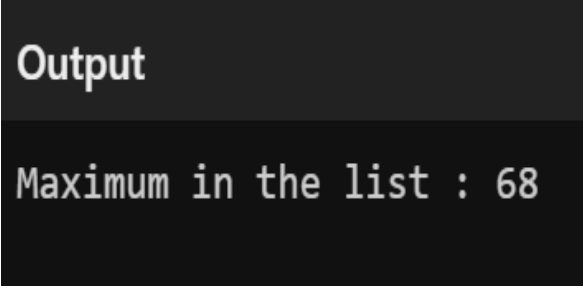
30. What is the difference between Xrange and range?
Xrange returns the xrange object while range returns the list, and uses the same memory no matter what the range size is.
31. What does len() do?
The len() function in Python is used to determine the length or the number of items in an iterable object such as a string, list, tuple, dictionary, or set. It returns the count of elements present in the object.
Here are a few examples:
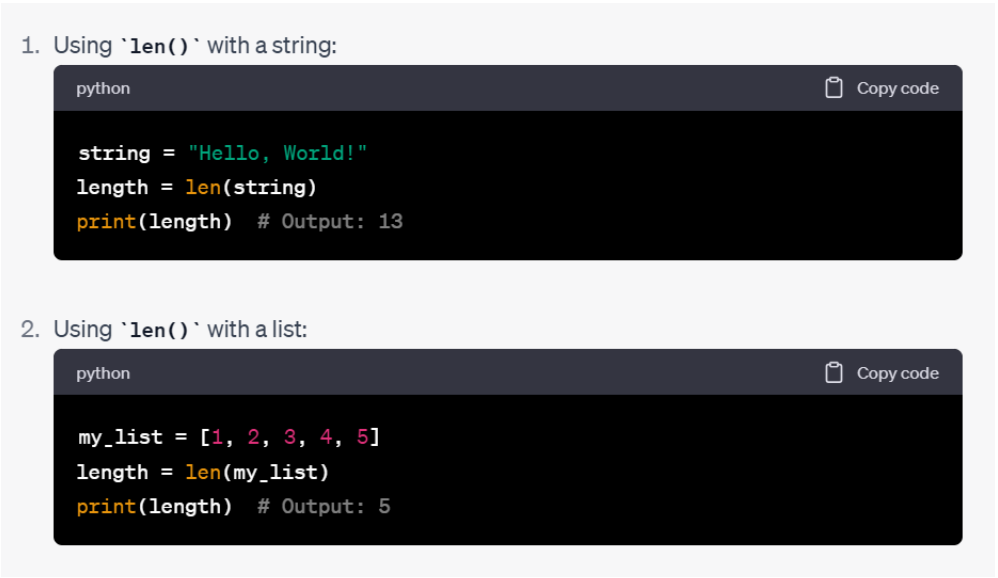
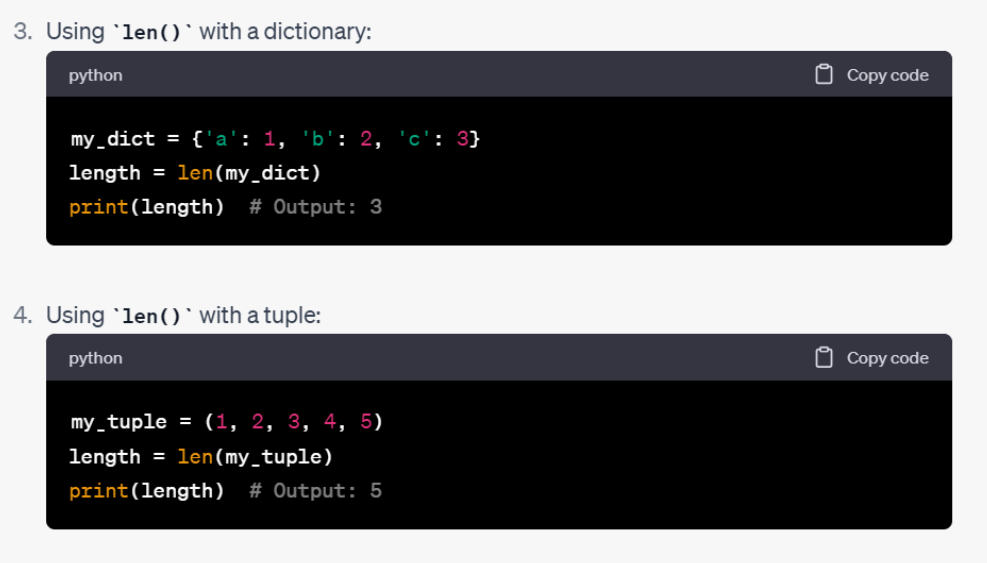
32. How will you check in a string that all characters are decimal?
isdecimal() − Returns true if a unicode string contains only decimal characters and false otherwise.
33. What is a docstring?
The docstring in Python is also called a documentation string, it provides a way to document the Python classes, functions, and modules.
34. What is the difference between print and return?
The print does not store any value. It simply prints the value, whereas return gives the value as an output that can be stored in a variable or a data structure.
35. How will you get all the keys from the dictionary?
print(dict.keys())
36. How will you get all the values from the dictionary?
print(dict.values())
Elevate your Python skills with our Python Training program.
Suggested blogs
14 December 2023
30 November 2023
Recent blogs

21 February 2025
|
06 February 2025
|